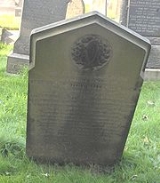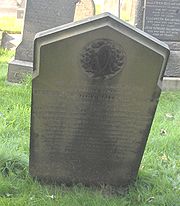
Spencer Timothy Hall
Encyclopedia
Spencer Timothy Hall was an English
writer and mesmerist. He was born in a cottage near Sutton in Ashfield in Sherwood Forest
, Nottinghamshire
, the son of Samuel Hall, a Quaker cobbler and Eleanor Spencer, a dairy
maid. He received some education from his father and at seven years of age entered the weaving trade.
After reading the life of Benjamin Franklin
, Hall resolved to become a printer. In January 1829 he went to Nottingham and was apprenticed at the office of The Mercury newspaper. He began writing poetry, and by 1832 he was contributing verse to The Mirror, The Metropolitan Magazine
and other periodicals.
In 1836 Hall returned to Sutton in Ashfield, where he started his own printing and bookselling business, and printed a monthly periodical called the Sherwood Magazine, in which he published his work under the name of ‘The Sherwood Forester’. In May 1839 he joined the printing firm Hargrove at York
. In 1841 he published a volume of prose and verse entitled The Forester's Offering. The book earned Hall an invitation from James Montgomery to Sheffield, where he became co-editor of The Iris newspaper and governor of the Hollis Hospital. He wrote a volume of prose sketches entitled Rambles in the Country for The Iris; it was reissued in an enlarged form in 1853 as The Peak and the Plain. As the result of a visit to Ireland
in the famine years he published Life and Death in Ireland as Witnessed in 1849 (1850).
Hall was also interested in popular scientific movements. He was the first honorary secretary of the Sheffield Phrenological Society and later an honorary member of the Phrenological Society of Glasgow. In 1841 he learned about mesmerism from watching some spectacular demonstrations by a Frenchman named Lafontaine, who was touring northern England. Hall then taught himself mesmerism and began to make his own tours of the country, giving public demonstrations, offering tutelage and therapy, and selling copies of a journal he founded in 1843, The Phreno-Magnet, or, Mirror of Nature. His most illustrious patient was Harriet Martineau
, whom, it seems, he cured of an apparently hopeless disease of the uterus. Martineau was first diagnosed in 1839; after over five years of suffering, she was introduced to mesmerism by her brother-in-law, who had been impressed by one of Hall's lectures in Newcastle. ‘Everything that medical skill and family care could do for me had been tried, without any avail’, Martineau wrote in her Autobiography (1877), ‘Now that a new experiment was proposed to me … I had nothing to do but try it’.
About 1852 Hall became a homoeopathic doctor, and published Homoeopathy: a Testimony (1852). He was granted the honorary degrees of MA and PhD
from Tübingen.
He was married twice: his first wife, Sarah, died only nine months after their wedding; his second marriage produced several children. He died at Blackpool on 26 April 1885, and was buried in Layton Cemetery
.

English people
The English are a nation and ethnic group native to England, who speak English. The English identity is of early mediaeval origin, when they were known in Old English as the Anglecynn. England is now a country of the United Kingdom, and the majority of English people in England are British Citizens...
writer and mesmerist. He was born in a cottage near Sutton in Ashfield in Sherwood Forest
Sherwood Forest
Sherwood Forest is a Royal Forest in Nottinghamshire, England, that is famous through its historical association with the legend of Robin Hood. Continuously forested since the end of the Ice Age, Sherwood Forest National Nature Reserve today encompasses 423 hectares surrounding the village of...
, Nottinghamshire
Nottinghamshire
Nottinghamshire is a county in the East Midlands of England, bordering South Yorkshire to the north-west, Lincolnshire to the east, Leicestershire to the south, and Derbyshire to the west...
, the son of Samuel Hall, a Quaker cobbler and Eleanor Spencer, a dairy
Dairy
A dairy is a business enterprise established for the harvesting of animal milk—mostly from cows or goats, but also from buffalo, sheep, horses or camels —for human consumption. A dairy is typically located on a dedicated dairy farm or section of a multi-purpose farm that is concerned...
maid. He received some education from his father and at seven years of age entered the weaving trade.
After reading the life of Benjamin Franklin
Benjamin Franklin
Dr. Benjamin Franklin was one of the Founding Fathers of the United States. A noted polymath, Franklin was a leading author, printer, political theorist, politician, postmaster, scientist, musician, inventor, satirist, civic activist, statesman, and diplomat...
, Hall resolved to become a printer. In January 1829 he went to Nottingham and was apprenticed at the office of The Mercury newspaper. He began writing poetry, and by 1832 he was contributing verse to The Mirror, The Metropolitan Magazine
The Metropolitan Magazine
The Metropolitan: a monthly journal of literature, science, and the fine arts was a London monthly journal established by Thomas Campbell in 1831....
and other periodicals.
In 1836 Hall returned to Sutton in Ashfield, where he started his own printing and bookselling business, and printed a monthly periodical called the Sherwood Magazine, in which he published his work under the name of ‘The Sherwood Forester’. In May 1839 he joined the printing firm Hargrove at York
York
York is a walled city, situated at the confluence of the Rivers Ouse and Foss in North Yorkshire, England. The city has a rich heritage and has provided the backdrop to major political events throughout much of its two millennia of existence...
. In 1841 he published a volume of prose and verse entitled The Forester's Offering. The book earned Hall an invitation from James Montgomery to Sheffield, where he became co-editor of The Iris newspaper and governor of the Hollis Hospital. He wrote a volume of prose sketches entitled Rambles in the Country for The Iris; it was reissued in an enlarged form in 1853 as The Peak and the Plain. As the result of a visit to Ireland
Ireland
Ireland is an island to the northwest of continental Europe. It is the third-largest island in Europe and the twentieth-largest island on Earth...
in the famine years he published Life and Death in Ireland as Witnessed in 1849 (1850).
Hall was also interested in popular scientific movements. He was the first honorary secretary of the Sheffield Phrenological Society and later an honorary member of the Phrenological Society of Glasgow. In 1841 he learned about mesmerism from watching some spectacular demonstrations by a Frenchman named Lafontaine, who was touring northern England. Hall then taught himself mesmerism and began to make his own tours of the country, giving public demonstrations, offering tutelage and therapy, and selling copies of a journal he founded in 1843, The Phreno-Magnet, or, Mirror of Nature. His most illustrious patient was Harriet Martineau
Harriet Martineau
Harriet Martineau was an English social theorist and Whig writer, often cited as the first female sociologist....
, whom, it seems, he cured of an apparently hopeless disease of the uterus. Martineau was first diagnosed in 1839; after over five years of suffering, she was introduced to mesmerism by her brother-in-law, who had been impressed by one of Hall's lectures in Newcastle. ‘Everything that medical skill and family care could do for me had been tried, without any avail’, Martineau wrote in her Autobiography (1877), ‘Now that a new experiment was proposed to me … I had nothing to do but try it’.
About 1852 Hall became a homoeopathic doctor, and published Homoeopathy: a Testimony (1852). He was granted the honorary degrees of MA and PhD
PHD
PHD may refer to:*Ph.D., a doctorate of philosophy*Ph.D. , a 1980s British group*PHD finger, a protein sequence*PHD Mountain Software, an outdoor clothing and equipment company*PhD Docbook renderer, an XML renderer...
from Tübingen.
He was married twice: his first wife, Sarah, died only nine months after their wedding; his second marriage produced several children. He died at Blackpool on 26 April 1885, and was buried in Layton Cemetery
Layton Cemetery
Layton Cemetery is a graveyard located at Talbot Road in Blackpool, Lancashire in England. It was opened in 1873 when Blackpool parish church was replete with burying. The site encompasses , having being regularly expanded during its history. It is administered by Blackpool Council...
.


